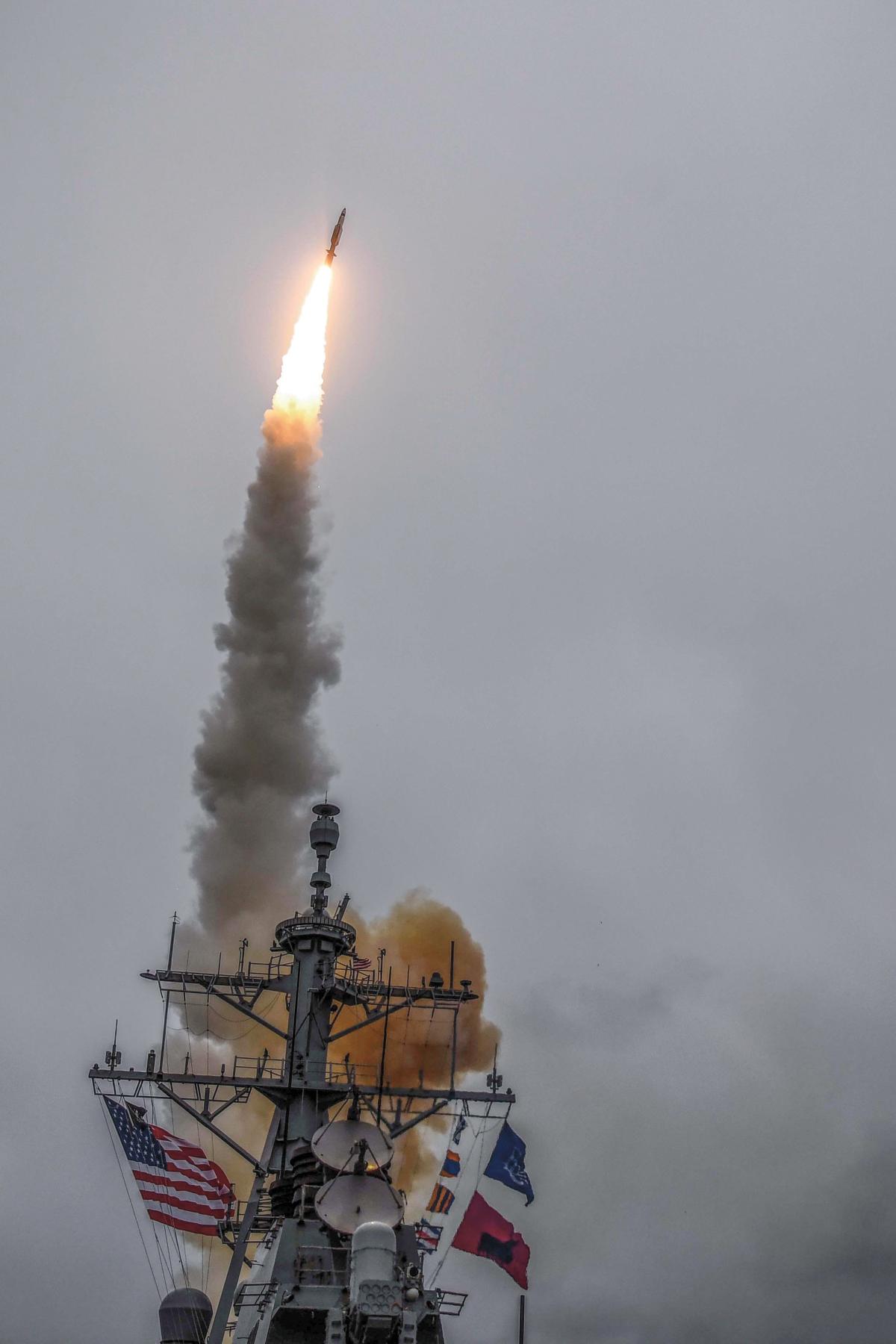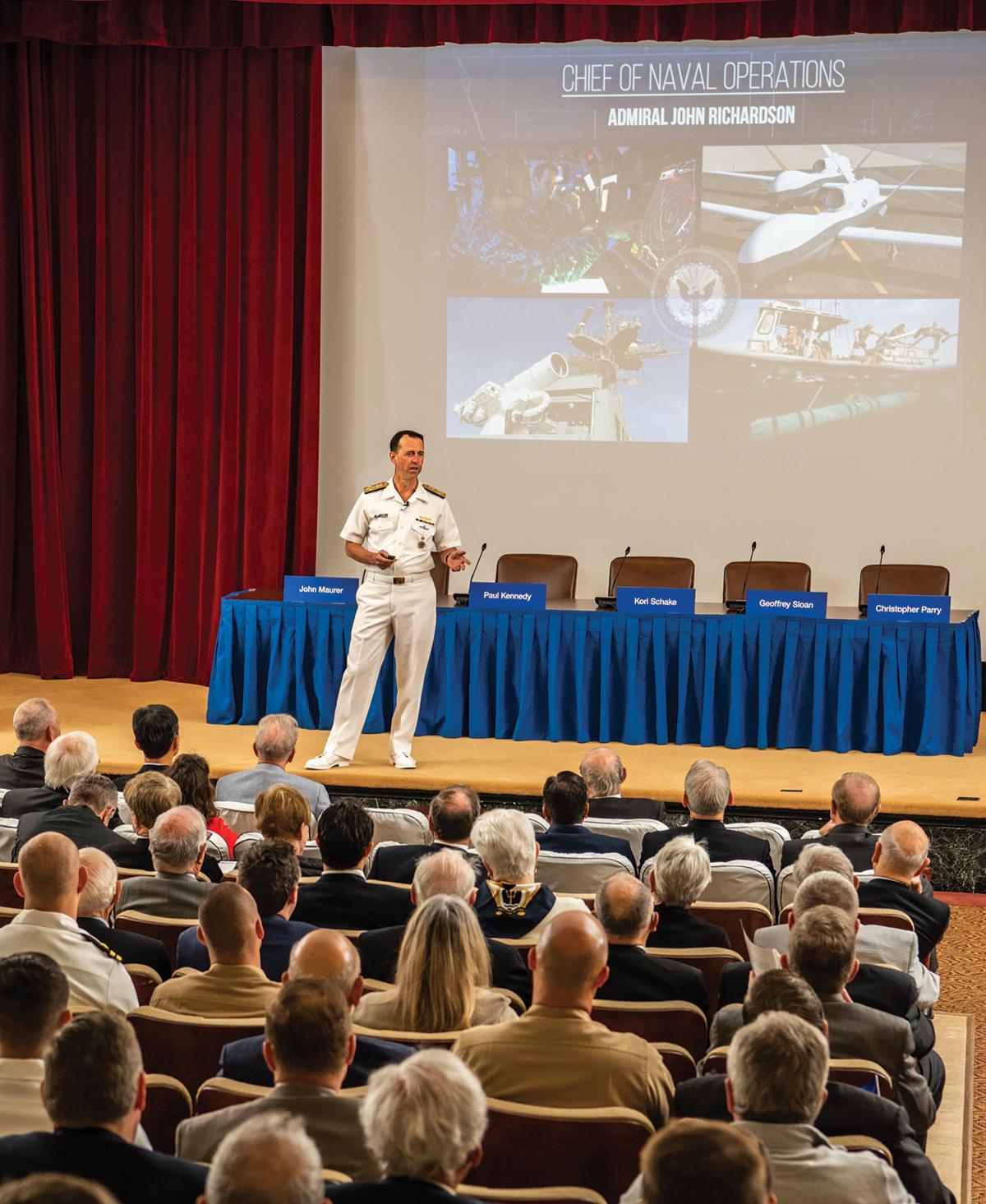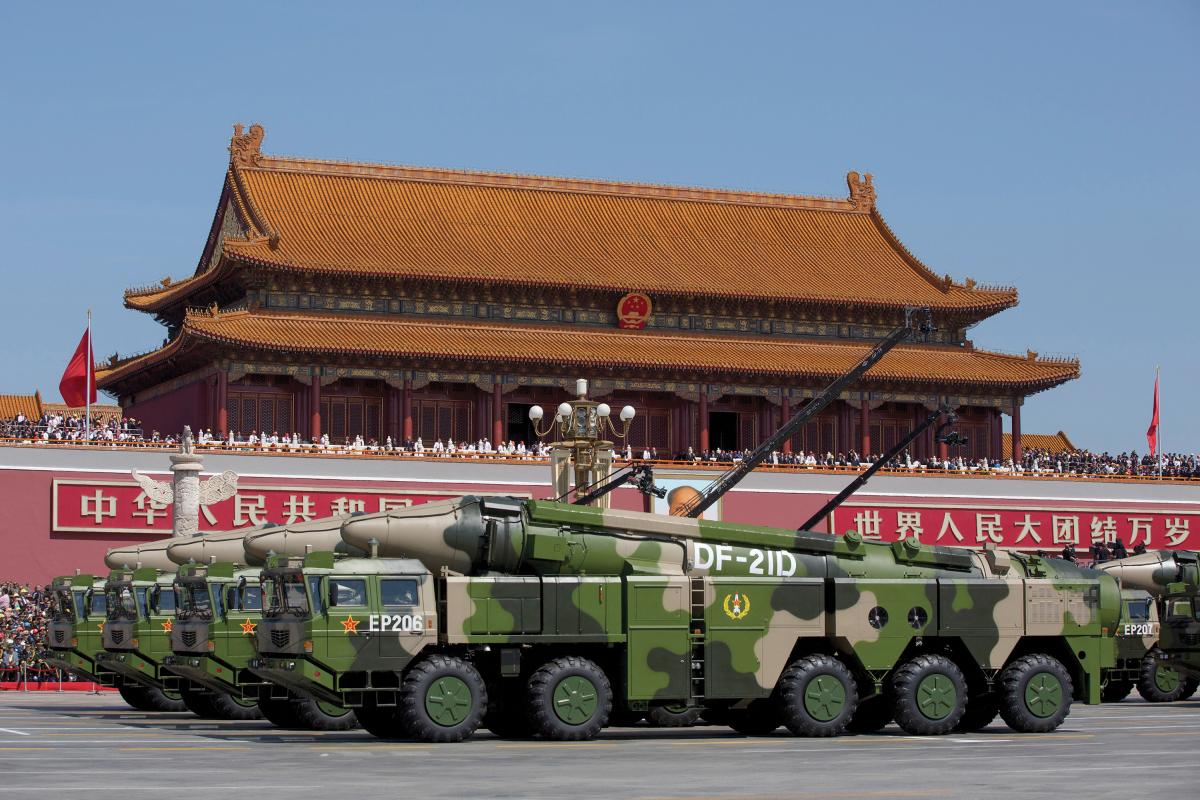Last June, Defense News broke a story that the Navy was through with ballistic missile defense (BMD) patrols. This conclusion was based on comments made by then-Chief of Naval Operations (CNO) Admiral John Richardson during the U.S. Naval War College’s 2018 Current Strategy Forum. There, he expressed frustration with committing “six multimission, very sophisticated, dynamic cruisers and destroyers” to “a tiny box, defending land.”1 Missing from this story, however, was his qualifying statement, “I want to get out of the long-term missile defense business and move to dynamic missile defense.” In this assessment, the CNO is on the mark. It is time the Navy gets out of the business of defending static land assets and reconsiders how ship-based BMD capabilities can best contribute to countering the missile threat.
The Navy should change how it employs Aegis BMD-capable ships for three reasons. The first, to which the CNO alluded, is that it underuses a limited asset. BMD ships are mobile, multimission surface combatants. There will never be enough Aegis cruisers and destroyers to meet all operational requirements. This means commanders must assess risk, establish priorities, and allocate resources accordingly. Facing peer or near-peer adversaries, commanders will be required to employ surface combatants when and where they are most needed and will need the flexibility to redeploy them when threats change or opportunities arise. Limiting ships to a single mission in a small geographic area is an inefficient use of a multimission asset and not justifiable when viable alternatives exist.
The second reason is that against a peer competitor or even a moderately competent regional adversary, operating in a constrained geographic area while radiating the powerful SPY-1 radar is not tenable. A ship operating in this manner is comparatively easy to target and vulnerable to threats such as antiship missiles, submarines, suicide boats, and mines. An Aegis ship on station remains formidable but is not invulnerable and would require forces to defend it. This would only exacerbate the lack of surface combatants. The Navy clearly recognizes the threat posed by antiaccess/area-denial weapons, and adopting concepts such as electronic maneuver warfare (EMW) and distributed maritime operations (DMO) aims to increase agility and expand the battlespace. Operating in a tiny box does not align with these concepts.
The final reason is that in most scenarios, ships are not going to be very good at defending land-based assets. This is primarily an issue of capacity. Potential adversaries are fielding missiles of increased range, accuracy, flexibility, and survivability. But beyond the impressive technological improvements, these weapons are being fielded in staggering numbers. U.S. adversaries possess extensive inventories of short- and medium-range ballistic missiles.2 With China and Russia, ballistic missile forces are complemented by an equal or perhaps greater number of land-attack cruise missiles. Against these numbers, by 2020 the U.S. Navy will have fewer than 400 Standard Missile (SM)-3s, of which 150 will be the older SM-3 Block I or IA (some nearing retirement age).3 There will be more SM-6s, but their BMD requirements will have to compete with those for air defense and antisurface warfare.
Furthermore, the available Navy-wide SM-3 and SM-6 inventory has to be divided among the various geographic combatant commands and must compete for shipboard vertical launch system space with SM-2 and Tomahawk land-attack missiles. In most cases, a single ship faces an unsolvable math problem. BMD patrols do deter adversaries and reassure allies of U.S. commitment. But the Navy is writing a check it cannot cash. This might be acceptable if there were no alternative. However, defending static land-based assets can be better accomplished by land-based BMD systems.
Time to Redefine Navy BMD
That the Navy is ill-suited to defending land assets does not mean it should abandon BMD. It does mean the Navy needs to rethink the mission and determine how Aegis BMD capability can best benefit the joint force. One area in which the Navy can uniquely contribute is in protecting aircraft carriers and amphibious ships from antiship ballistic missiles (ASBMs). If this sounds like a self-licking ice cream cone, consider the comparative vulnerability of an air base. While the Navy has agonized over the ASBM threat for years, the missile threat to land bases is far greater. It is impossible to move or hide an airbase. China, Russia, Iran, and North Korea all possess large inventories of missiles that can reach forward U.S. bases. Land-based BMD forces are capable and deploy with a greater number of antiballistic missile interceptors, but in a conflict they will be hard-pressed to defend forward bases. This means that a great deal of, if not most, U.S. forward power projection capability will be sea based. To ensure that capability remains survivable will require missile defenses that only the Navy can provide.
The inherent mobility of Aegis ships offers a surge capability. Aegis ships can defend amphibious forces during a raid, an evacuation, or until organic BMD can be established ashore. These ships can defend a port during a force debarkation or a forward-based expeditionary airfield when aircraft are present, or they can augment land-based BMD elements. Finally, Navy ships can surge to augment land-based BMD forces in the event the threat should outstrip the land-based BMD capability or in the event of casualties. Employed as a surge force, BMD ships are a ready deployable reserve for the joint commander, easing ship capacity constraints and risk to the ships.
Shifting the Navy’s BMD focus entails challenges. Though the Navy has retained control of ships on BMD stations, they are essentially geographic component commander theater assets. For joint force air component commanders (JFACCs), Aegis ships are their BMD assets, present in theater solely to meet national or regional BMD requirements. Even when land-based BMD forces are present, the JFACC will want to retain these forces to provide additional or backup capability. This may overstate the case, and this tendency may be more pronounced in peacetime when there are no obvious opportunity costs involved with locking an Aegis ship “in a tiny box.” But there is no denying that breaking this paradigm will be a challenge. The Navy must explain why refocusing sea-based BMD is not a parochial concern but critical to the joint effort. Given the former CNO’s comments, it appears this may be in progress.
Missile Defense in a Larger Context
Rethinking BMD requires changing how the Navy views the mission. Already the threats posed by maneuvering reentry vehicles, ASBMs, long-range cruise missiles, and hypersonic glide vehicles are blurring the distinction between BMD and air defense. Until recently, the Department of Defense treated BMD as a unique mission deserving special treatment. This is no longer practicable. Nor is relying on destroying missiles in flight. The numerical imbalance between threat missiles and interceptors and a punishing cost exchange ratio mean that shooting down all the missiles is impractical and unaffordable, even if air and missile defenses are highly effective.4 Therefore, the Navy and the other services must embrace integrated air and missile defense (IAMD) and adopt what the 2019 Missile Defense Review calls a comprehensive approach.5 Hard-kill systems must be combined with other offensive attack operations, such as electronic and cyber-attack operations, to counter an adversary’s targeting capabilities and kill chain both left and right of launch. While the services have paid lip service to IAMD for years, the time has come to break the rice bowls and integrate the various tools available to counter air and missile threats.
Shifting the Navy’s focus to a holistic approach to missile defense, instead of only BMD, and focusing on fleet missile defense and surge capability will require changes to doctrine, organization, training, material, leadership, personnel, and facilities. The first step is to adjust to expanded threats, which now include cruise missiles, unmanned aerial vehicles, and, soon, hypersonic glide vehicles. Instead of focusing on small numbers of missiles launched by rogue states, the fleet will have to prepare for multiple missile salvos. These likely will be employed in structured attacks, featuring dissimilar weapons (ASBM and antiship cruise missiles, for example) and electronic and cyber attacks. The Navy should expect that the enemy will understand the physical limitations of its shipboard systems and will attempt to stress sensor networks, degrade communications, and overwhelm Aegis missile-defense capability and capacity. The Navy’s tactics and material systems will have to be adjusted accordingly.
The dilemma posed by large numbers of missiles cannot be solved simply by acquiring more of the systems employed today. As the Navy reorients its focus, it must recognize that the primary objective of air and missile defense is not to shoot down missiles. This is particularly true when defending high-value maritime assets. Targeting the adversary’s sensors and communications through a combination of signature control, maneuver, deception, physical destruction, and cyber attacks will be the first line of defense. Offensive actions against the enemy’s missile forces and supporting infrastructure will be the second. At some point, however, ships will be unable to remain untargeted, either through error or operational necessity. Ships must be able to defend themselves and the high-value assets for the period required to accomplish the mission.
In the absence of a revolutionary directed-energy weapon, surface-to-air missiles, gun systems, jamming systems, and decoys will remain the tools of this fight. To survive, ships will have to synergistically employ kinetic and nonkinetic weapons. The complexity of these calculations and the limited decision time will require effective doctrine aided by networked, tactical decision aids.
New Organization and Systems
The threat environment also will force changes in how the Navy organizes air- and missile-defense forces. Since the aircraft carrier emerged as the primary Navy offensive force in World War II, the concept behind air defense has remained largely unchanged. Fighter aircraft and surface combatants form a layered screen for the carrier. Advances in air- and missile-defense technology increased weapons capability, and the size of battle groups decreased, but the fundamental principles of air and missile defense remain the same. Implementing DMO, distributed lethality, dynamic force employment, and EMW will require a different paradigm. One thing is certain—operations will be a far more difficult undertaking than today’s BMD deployment. Solving these challenges will require developing not only innovative operational concepts and doctrine, but also intense training at the shipboard, tactical-group, and task-force levels.
Finally, the type of systems the Navy fields also will have to change. Much of the service’s focus to date, including recent advances such as the SM-3 Block IIA, represents a joint Missile Defense Agency–Navy effort directed at limited numbers of long-range threats—hence the Navy has procured small numbers of highly capable and very expensive interceptors. The stark reality of comparative missile inventories (offensive missiles versus interceptors) will necessitate a shift to nonkinetic, directed-energy weapons and different (and cheaper) forms of hard-kill weapons. One suggestion from the Center for Strategic and Budgetary Assessments study, Winning the Salvo Competition, is to shift from long-range to “lower-cost medium-range kinetic interceptors,” guns, and directed-energy weapons.6 While engaging threats at closer range may seem counterintuitive, kinetic antimissile weapons require a predictable flight path to account for interceptor fly-out time, and ship-based electronic-attack and directed-energy weapons cannot be engaged beyond the horizon. One point in the trajectory where the missile’s path is highly predictable and in range is in the final moments of flight, when the missile is heading directly at its target. This is nerve-racking for sure, but potentially effective, particularly if decoys and electronic attack can simultaneously be employed with short-range interceptors and directed-energy weapons.
Evolving air and missile threats, the limitations of Aegis BMD ships, changes called for in the Missile Defense Review, and, of course, the former CNO’s comments, indicate the Navy must rethink its BMD mission. The new norm will require planning and executing combined air and missile defense in an environment where flexibility is essential, capability distributed, and forces dispersed. The effort will be more complex than heading to a fixed location focused on a single BMD mission. Execution will put a premium on highly trained shipboard personnel and on staffs to understand the mission, the threat, and the range of capabilities the force can employ. It will involve dedicating the necessary time and effort to develop the operational concepts and doctrine that will fully integrate the tools of air and missile defense. Success will require investing in the proper hard- and soft-kill capabilities and training the fleet to employ them. If this seems a high cost, the alternative is less palatable.
1. David B. Larter, “The Navy Is Fed Up with Ballistic Missile Defense Patrols,” Defense News, 16 June 2018.
2. Exact missile inventories are classified, but Secretary of State Mike Pompeo has acknowledged that Iran has a ballistic missile inventory numbering in the hundreds (presentation to the United Nations Security Council, 12 December 2018). In China Military Power, 2019, the Defense Intelligence Agency acknowledges that China has an inventory of at least 1,200 short-range missiles and unspecified numbers of medium- and intermediate-range missiles.
3. Office of the Under Secretary of Defense (Comptroller)/Chief Financial Officer, United States Department of Defense Fiscal Year 2019 Budget Request—Program Acquisition Cost by Weapon System, February 2018.
4. The cost-exchange ratio is the difference between the cost of the ballistic missile and that of the ballistic missile interceptor and its related systems.
5. IAMD does not refer to simultaneous air defense and BMD hard-kill defenses on board a single ship, but rather to the “integration of capabilities and overlapping operations,” specifically, offensive-defensive integration. See Joint Publication 3-01, Countering Air and Missile Threats, 21 April 2017.
6. Mark Gunzinger and Bryan Clark, Winning the Salvo Competition, Center for Strategic and Budgetary Assessments, 20 May 2016.





